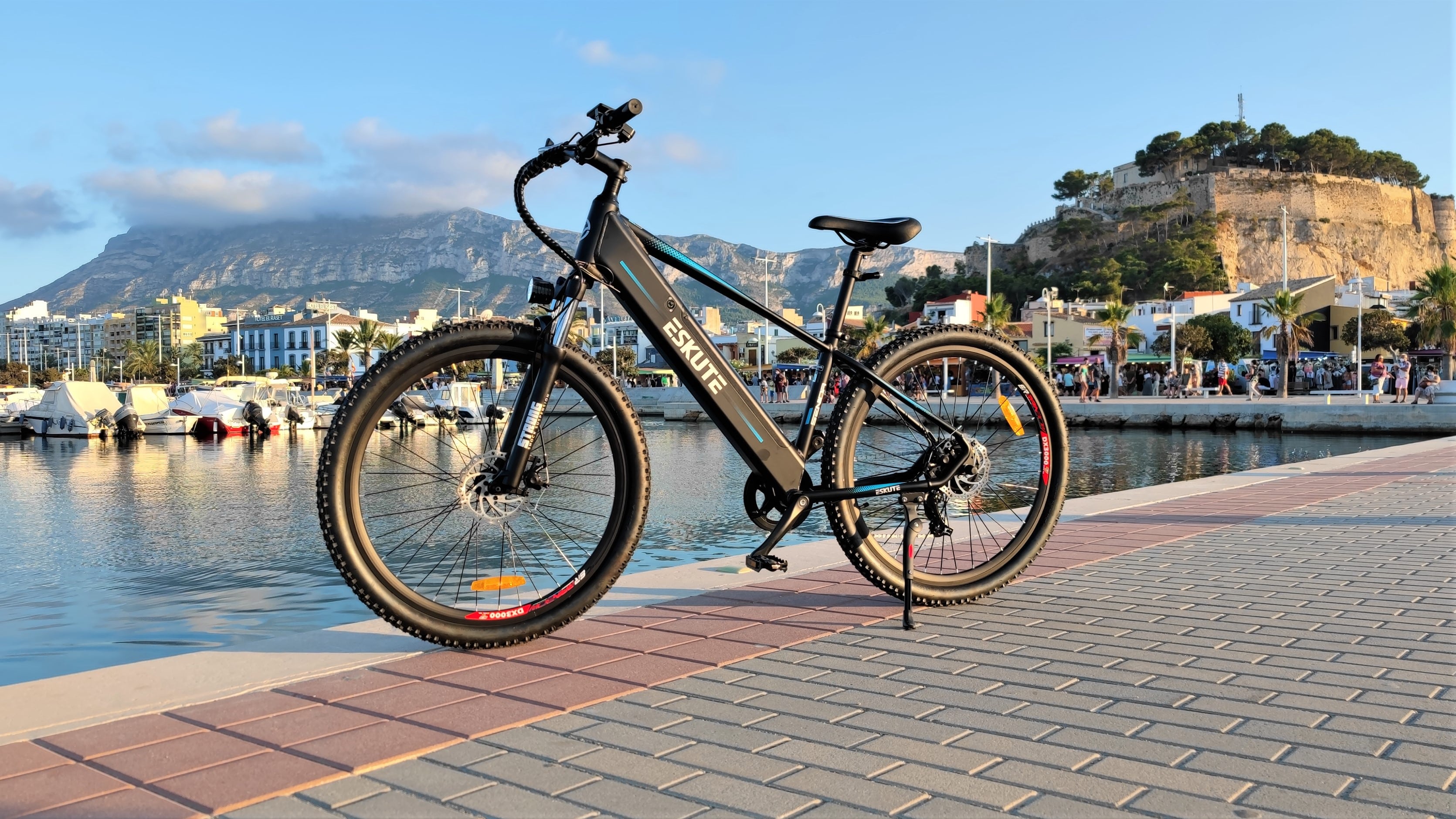Navigation
Knowing about an electric bike's geometry can help determine the handling, feel, and comfort. It's almost as important as the striking looks an e-bike can have.
The standard display of size, head and seat tube length, top tube length, and many more are usually displayed on general e-bike websites. But what use is it when everything you read is practically nothing?
It's one thing to know about numbers, but understanding what they mean is entirely different.
This article by our Lovely Eskute writer, Croompp, spells out what each measurement means to you and your e-bike, all to ensure you have the best possible outcome for whatever you plan to engage your e-bike for.
General Anatomy of an E-bike
Measurements are essential, so here's a chart for you to relate to the most common vital areas of an E-bike.
A - Top Tube
B - Head Tube
C - Seat Stay
D - Seat Tube
E - Down Tube
F - Fork
G - Rear drop out
H - Chain Stay
I - Centre of Bottom Bracket
J - Front drop out
Size. It's always different unless Centimeters(cm)
A key point to note is that unless measured in cm, which is the general measurement unit for a bike, much less an e-bike. It will differ. Manufacturers often include "small, medium, large," which are not universal or governed by any standards.
Proper measurements like "51cm, 54cm, 56cm are vitally important when picking an E-bike. The disparity in measurements is usually the manufacturer's fault. For most cases, they may measure the seat tube length of a bike as 51cm and describe it as "small." For other manufacturers, that kind of measurement may result in being an "x-small." See the difference?
Therefore, the quoted size of an e-bike may not be as accurate and helpful when comparing across brands.
Stack and Reach
Stack and Reach are the two measurements you need to know. They immediately help determine whether electric bikes from opposing manufacturers suit you.
Stack is the vertical distance from the bottom bracket to the top of the head tube. This indicates how tall the frame is. A brief example will be how endurance road bikes will have a larger stack than race-oriented bikes.
Reach is the horizontal distance from the bottom bracket to the top center of the head tube. This indicates how long the frame is. A brief explanation is how performance bikes will have a greater reach due to better aerodynamics (lower frontal profile) when riding.
A rider's arm length is also a determinant of Reach. This is called Rider's Reach. Measured from the tip of the saddle to the end of the stem. It includes variability due to the interchangeable height of the seat.
Head Tube
Two measurements you need to remember when it comes to head tube - angle & length.
Head tube angle refers to the perpendicular angle to the ground, often described as "slack, or steep". A slack head tube angle performs better at slow speeds but more effort to steer.
Vice versa for a steep head tube angle. Most commonly found on performance bikes, a more vertical angle is better at high velocity, requiring lesser effort to steer.
Head tube length is measured from the top to the bottom of the tube. A longer head tube puts the rider in a more upright position. A shorter head tube lowers the front of the bike, promoting aerodynamics from diminishing the frontal profile of the rider.
Fork Rake
The fork rake is a crucial component in handling the e-bike as it is directly associated with the front wheel. Imagine looking down from the top of the handlebar, followed by the head tube, to give you an idea. Piece together an imaginary line that intersects each line. That intersection angle is called the Fork Rake in road bikes or Fork Offset in mountain bikes.
An increase in the offset directly affects steering. Conversely, decreasing it lowers the steer.
Tidbits: Fork Rake is only one page of the steering book. Increasing the offset generally adds length to the wheelbase, much needed in endurance bikes for more stability.
Seat Tube
The seat tube angle generally hovers around 71-74 degrees in most bikes. It's the seat angle with relativity to the ground.
It is measured from either the center of the bottom bracket to where the top tube and seat tube meet (Centre-Centre or C-C) or to the top of the seat tube (Centre-Top or C-T).
Altering the saddle set back position (lowering or lengthening the saddle) will virtually influence the seat tube angle, making it slacker or steeper. Triathletes utilize this difference the most, moving their saddles forward (lower)to target their glutes and hamstrings when riding, resulting in lesser tension on their quads for better performance when running. Saddle setback is measured through the tip of the saddle to the bottom of the bracket.
Top Tube
The most common name for this is "effective top tube." I'm sure every rider has heard of this once or twice when choosing a new bike. When manufacturers do not give stack and reach measurements (mentioned above), this is the following best way to compare sizes between brands.
Chainstay Length
The chainstay length measures from the bottom bracket to the rear dropouts horizontally. This directly influences the wheelbase and handling. As we've talked about stability being proportional to handling, this is the perfect example. E-bikes with longer chainstay result in sharper handling due to reduced wheelbase.
Wheelbase
The wheelbase refers to the distance between the axle of both wheels. The head tube angle, fork rake, reach, and chainstay length all affect the wheelbase's length. 'Longer' equals more comfort and stability, whereas 'shorter' increases handling.
A sharp example would be touring and endurance e-bikes. Touring or endurance bikes tend to adopt longer wheelbases compared to performance-orientated models. Another would be cross-country e-bikes designed with shorter wheelbases when compared to downhill eMTBs.
Bottom Bracket Drop
The bottom bracket drop is the vertical displacement on the imaginary line formed by the axle of both wheels. It typically ranges from 60mm - 80mm and helps lower the rider's center of gravity, allowing more stability at varying speeds.
Things to take note of when having a lowered bottom bracket drop is the pedal clearance. Too low and risk scraping the pedals on whichever terrain you're at, resulting in damages or potential injuries.
Balance is the key to achieving the desired results.
Don't be confused with bottom bracket height, which is the distance measured from the ground. It generally means how much clearance the e-bike has from the ground up.
Other Measurements that are interchangeable
Stem Length - Switch out the stem of your current bike for a complete reach. Increasing the bike's stem can give the advantage of longer Reach, which might be more comfortable depending on your height. Stretching them out also creates a lower frontal profile. Swapping your stem is the first thing any rider would consider for a better ride.
Handlebar width - For a complete aerodynamic frame, swiping out the handlebar for something less bulky will do. However, the fact is that slimmer handlebars create 'shaky' handling. Wider bars better grip and control the flow but may create unnecessary drag, slowing down your overall ride. As you can expect, mountain bikes have thicker handlebars compared to their slimmer counterpart, road bikes.
Handlebar Reach - is the craze recently. It refers to the distance the handlebar pulls forward in relativity to the clamp area. Longer Reach equates to a more aggressive riding style, resulting in more speed, sacrificing comfort for the mass public.
Crank Length - Is vital for the clearance height of your bike. It influences the seat height and potentially other areas such as handlebar height and reach. A general favorite of e-bike manufacturer's install cranks that hovers around 170mm to 175mm. But depending on the rider's size, anywhere between 165mm to 180mm is permissible.
Seat Post - Most seat post measurements given are the maximum extended height. Ultimately, it depends on the rider's height. However, note that the saddle set back and seat tube length affect the general height and displacement of this.
End
Now that the information is flowing through your head. Why not take the time to appreciate and possibly test out your newfound knowledge on our Eskute E-bikes. If you're currently looking for an E-bike for commute, it's the best possible way to start.
Click here for our outdoor Voyager Series.
Or
Click here for our city Wayfarer Series.










Leave a comment
This site is protected by hCaptcha and the hCaptcha Privacy Policy and Terms of Service apply.